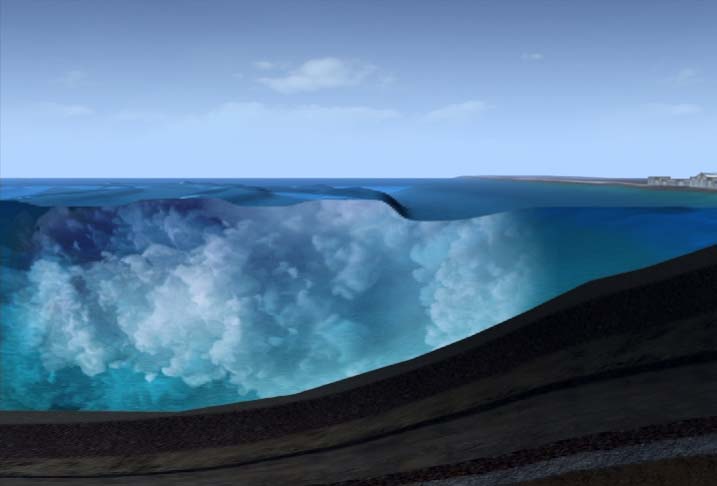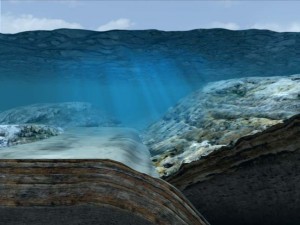TSUNAMI SCIENCE
Tsunamis are a force to be reckoned with. And that goes for creating them in 3D as well. The challenge was to explain to the viewers how tectonic plates work underneath the ocean floor. It’s obvious that while producers had to spend ample time explaining the concept, there would be no reason to include such complicated, factual information without visuals to help them understand. CBS has relied on TMBA’s animations in many situations like this and the tsunami show was no exception.
Tsunami is a Japanese word which means “harbor wave.” In the past these damaging ocean waves were sometimes known as tidal waves but, the term fell out of favor with the scientific community, because tsunamis have nothing to do with tides. Over 80% of tsunamis form in the Pacific Rim region. There is a geographically active area there known as the “Ring of Fire,” which is prone to volcanoes and earthquakes due to the existence of tectonic plate boundaries in the ocean floor. Tsunami facts can be difficult to understand and scientists are still attempting to determine what causes them and how to predict them earlier so lives can be saved.
The earth is actually made up of huge “plates” like a jigsaw puzzle. Where these plates fit together is known as the plate boundary. The causes of a tsunami are the plates when they shift against each other. In a divergent plate boundary, the plates move away from each other. Where there is a convergent plate boundary the plates push toward each other or collide. Transform boundaries are formed where plates shift past each other horizontally.
If the there is a shift, like an earthquake, on the ocean floor and a plate boundary rises or falls, it displaces the water above. The destructive force causes a tsunami to form. Volcanic eruptions and underwater landslides can also cause tsunamis. Most tsunamis happen when an earthquake causes what is called a “subduction zone.” This is an area where a plate is forced down into the earth’s layer known as the mantle. This causes enormous amount of friction, as the two plates move against each other extremely slowly. The under plate and an overriding plate essentially become stuck. This causes an accumulation of energy which can store up and build over decades or at times centuries. This is known as seismic energy.
As the seismic energy accumulates in the overriding plate it becomes stronger than the frictional force. There is a sudden motion as the plate on top moves back into a position where it is no longer restrained causing a catastrophic push to the water above. At the same time, the inland areas of the overriding plate move lower. The huge wave moves out across the water with such a long wavelength, that it loses very little energy. Water travels outward across the ocean but, water also rushes inward toward the newly lowered land at the shoreline.

A tsunami wave has a trough, which is the lowest point beneath the wave’s crest. The trough reaches inland first, and creates a vacuum that sucks up the coastal water near the shoreline away from the land, exposing the sea floor in harbors and inland areas. The is the first indicator that the destructive crest of the wave is on its way and can help save lives- there is about five minutes from the the time of the coastal water being sucked away and the arrival of the tsunami wave.
As a tsunami waves travel across deep water they may be only a foot or so high and hard to detect. Once it reaches inland, however the surge can reach heights of 100 feet or more, a massive wall of water that when it reaches land that can cause incredible destruction and loss of life. With wavelengths of up to 60 miles long these dangerous phenomenon can destroy long stretches of coastal areas. These waves are often part of a wave train, which is a series of waves and its mandatory to wait for an all clear before returning to the scene of a tsunami.
Next Page: Medical Animation Studio
Sorry, the comment form is closed at this time.

